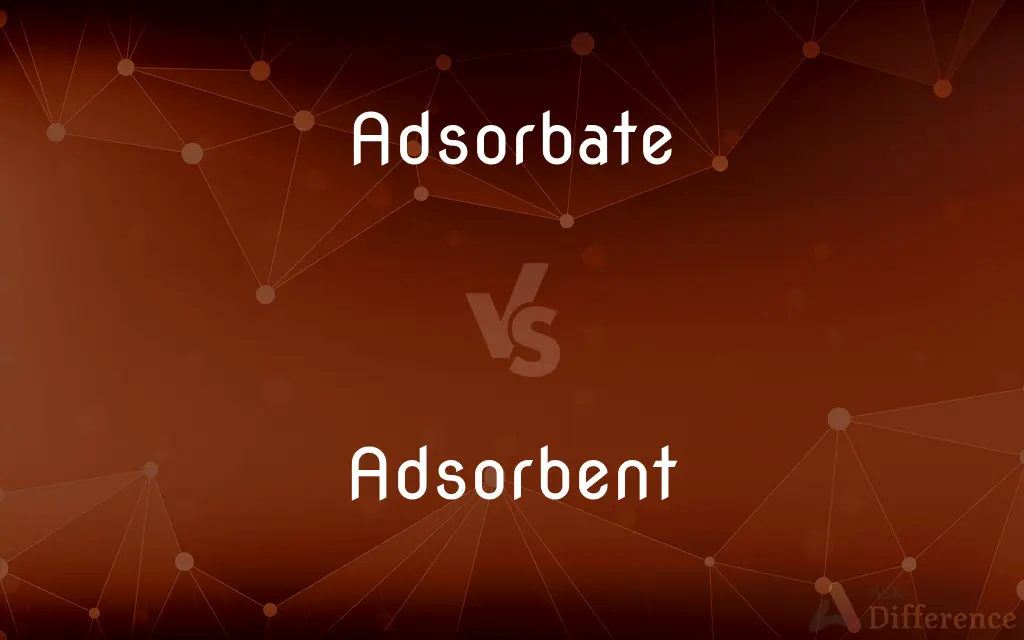Adsorbate vs. Adsorbent — What's the Difference?
Edited by Tayyaba Rehman — By Fiza Rafique — Updated on March 24, 2024
Adsorbate refers to the substance that is adsorbed onto another material's surface, while the adsorbent is the material that provides the surface for adsorption to occur.

Difference Between Adsorbate and Adsorbent
Table of Contents
ADVERTISEMENT
Key Differences
Adsorbate is the molecule or ion that adheres to the adsorbent's surface, participating in the process of adsorption by interacting with the adsorbent material. Whereas the adsorbent is the solid or liquid providing the surface on which the adsorption process takes place, characterized by its porosity and surface area.
The functionality of an adsorbate is defined by its ability to adhere to a surface, which is influenced by its chemical properties and the nature of the adsorbent. On the other hand, the effectiveness of an adsorbent is determined by its surface characteristics, including surface area, pore size, and the nature of its surface sites.
While the adsorbate is often a gas or liquid molecule attracted to the surface of the adsorbent, the adsorbent itself is typically a solid or highly porous material designed to maximize surface area for adsorption, such as activated carbon or silica gel.
Adsorption processes, involving adsorbates and adsorbents, are crucial in various applications, from water purification to air filtration. The adsorbate's role is to be captured or held on the surface, whereas the adsorbent provides the necessary platform for this interaction.
The selection of an adsorbent is critical in applications like catalysis or pollution control, as it must possess the right properties to interact effectively with the desired adsorbate. The specificity of the interaction between the adsorbate and adsorbent dictates the efficiency and selectivity of the adsorption process.
ADVERTISEMENT
Comparison Chart
Definition
Substance that adheres to a surface.
Material providing the surface for adsorption.
Role
To be adsorbed.
To adsorb.
Nature
Usually a gas or liquid molecule.
Typically a solid or highly porous material.
Key Properties
Chemical properties and interaction capability.
Surface area, porosity, and surface nature.
Application Examples
Pollutants in water purification, reactants in catalysis.
Activated carbon, silica gel, zeolites in filtration systems.
Compare with Definitions
Adsorbate
A substance attracted and held on the surface of another material.
In water treatment, chlorine is an adsorbate that gets removed by activated carbon.
Adsorbent
A material that provides a surface for substances to adhere to.
Silica gel is a common adsorbent used in drying processes.
Adsorbate
The component in the adsorption process that adheres to the adsorbent.
Carbon dioxide can be an adsorbate in air purification systems.
Adsorbent
Used to remove impurities or capture specific molecules.
Zeolites are used as adsorbents in the petrochemical industry for refining.
Adsorbate
Often a pollutant or undesired molecule in purification processes.
Heavy metals are adsorbates in industrial wastewater treatment.
Adsorbent
Often regenerable, allowing for repeated use in adsorption processes.
Adsorbents in air purifiers can be regenerated by heating or washing.
Adsorbate
Influenced by its chemical compatibility with the adsorbent.
Organic compounds are effective adsorbates on organic polymer adsorbents.
Adsorbent
Characterized by its high surface area and porosity.
Activated carbon, a widely used adsorbent, has a very high surface area.
Adsorbate
Can be a reactant in catalyzed reactions on solid surfaces.
Hydrogen molecules act as adsorbates in hydrogenation reactions.
Adsorbent
The effectiveness depends on the physical and chemical properties.
Metal-organic frameworks are engineered adsorbents with high selectivity.
Adsorbate
An adsorbed substance.
Adsorbent
Capable of adsorption.
Adsorbate
A substance that has been adsorbed
Adsorbent
An adsorptive material, such as activated charcoal.
Adsorbate
A material that has been or is capable of being adsorbed
Adsorbent
Tending to adsorb.
Adsorbate
Capable of being adsorbed or accumulated on a surface of a solid
Adsorbent
The solid or liquid in the process of adsorption on which the adsorbate accumulates.
Adsorbent
A material having capacity or tendency to adsorb another substance
Adsorbent
Having capacity or tendency to adsorb or cause to accumulate on a surface
Common Curiosities
Can any material act as an adsorbent?
While many materials can act as adsorbents, the most effective ones are those with high surface areas, porosity, and suitable chemical properties for the desired adsorption.
Why is the surface area of an adsorbent important?
A higher surface area provides more sites for adsorbates to adhere to, enhancing the adsorption capacity of the adsorbent.
What is an adsorbent?
An adsorbent is a material, typically solid, that provides a surface for other substances to adhere to through the process of adsorption.
How do adsorbates interact with adsorbents?
Adsorbates adhere to the surface of adsorbents through physical or chemical bonds, depending on the nature of both the adsorbate and the adsorbent.
What factors affect the choice of an adsorbent for a specific application?
Factors include the nature of the adsorbate, desired efficiency, pore size of the adsorbent, chemical compatibility, and regeneration ability.
Can adsorption be reversed?
Yes, adsorption can often be reversed through processes like heating or washing, allowing the regeneration and reuse of the adsorbent.
Are adsorbents always solid?
Adsorbents are typically solid to provide a stable surface for adsorption, though highly porous liquids can also sometimes act as adsorbents.
How does adsorption differ from absorption?
Adsorption is the adhesion of molecules to a surface, while absorption involves the bulk incorporation of a substance into another material.
What is an adsorbate?
An adsorbate is a substance that gets adsorbed onto the surface of another material, usually in the form of gas or liquid molecules.
How can the effectiveness of an adsorbent be increased?
Effectiveness can be increased by enhancing surface area, optimizing pore size, and modifying surface chemistry to improve interaction with the adsorbate.
What is a desorbent?
A desorbent is a substance used to release adsorbed materials from the adsorbent surface, often used in the regeneration of adsorbents.
Can temperature affect adsorption?
Yes, temperature can significantly affect the adsorption process, with higher temperatures often leading to decreased adsorption capacity.
Can adsorption be selective?
Yes, adsorption can be selective based on the size, shape, and chemical properties of the adsorbate, as well as the characteristics of the adsorbent.
What are some common uses of adsorption?
Common uses include air and water purification, separation of chemicals, catalysis, and in gas masks and respirators.
Is the adsorption process always beneficial?
While often beneficial in applications like purification, adsorption can sometimes have negative effects, such as the unintended removal of beneficial compounds.
Share Your Discovery

Previous Comparison
Easily vs. Easy
Next Comparison
Anime vs. MangaAuthor Spotlight
Written by
Fiza RafiqueFiza Rafique is a skilled content writer at AskDifference.com, where she meticulously refines and enhances written pieces. Drawing from her vast editorial expertise, Fiza ensures clarity, accuracy, and precision in every article. Passionate about language, she continually seeks to elevate the quality of content for readers worldwide.
Edited by
Tayyaba RehmanTayyaba Rehman is a distinguished writer, currently serving as a primary contributor to askdifference.com. As a researcher in semantics and etymology, Tayyaba's passion for the complexity of languages and their distinctions has found a perfect home on the platform. Tayyaba delves into the intricacies of language, distinguishing between commonly confused words and phrases, thereby providing clarity for readers worldwide.














































